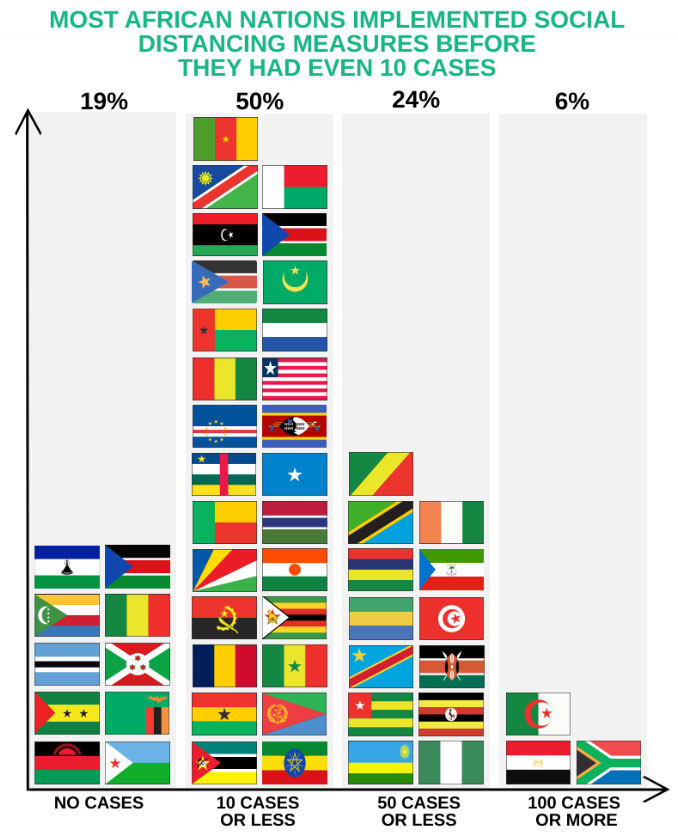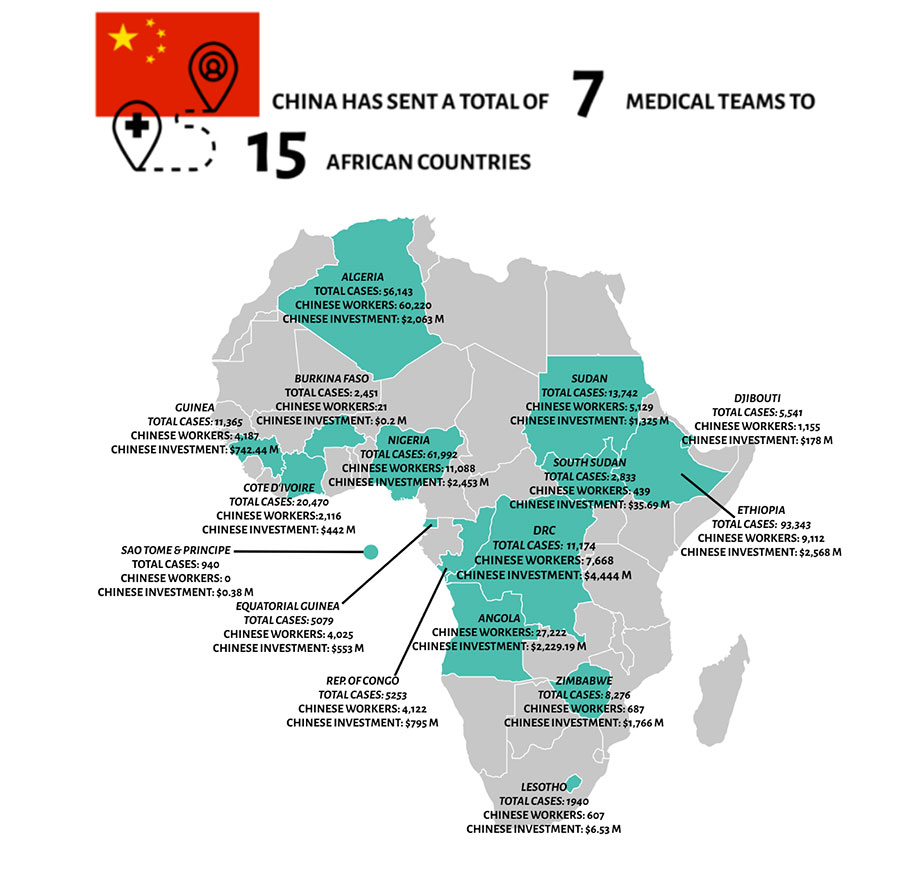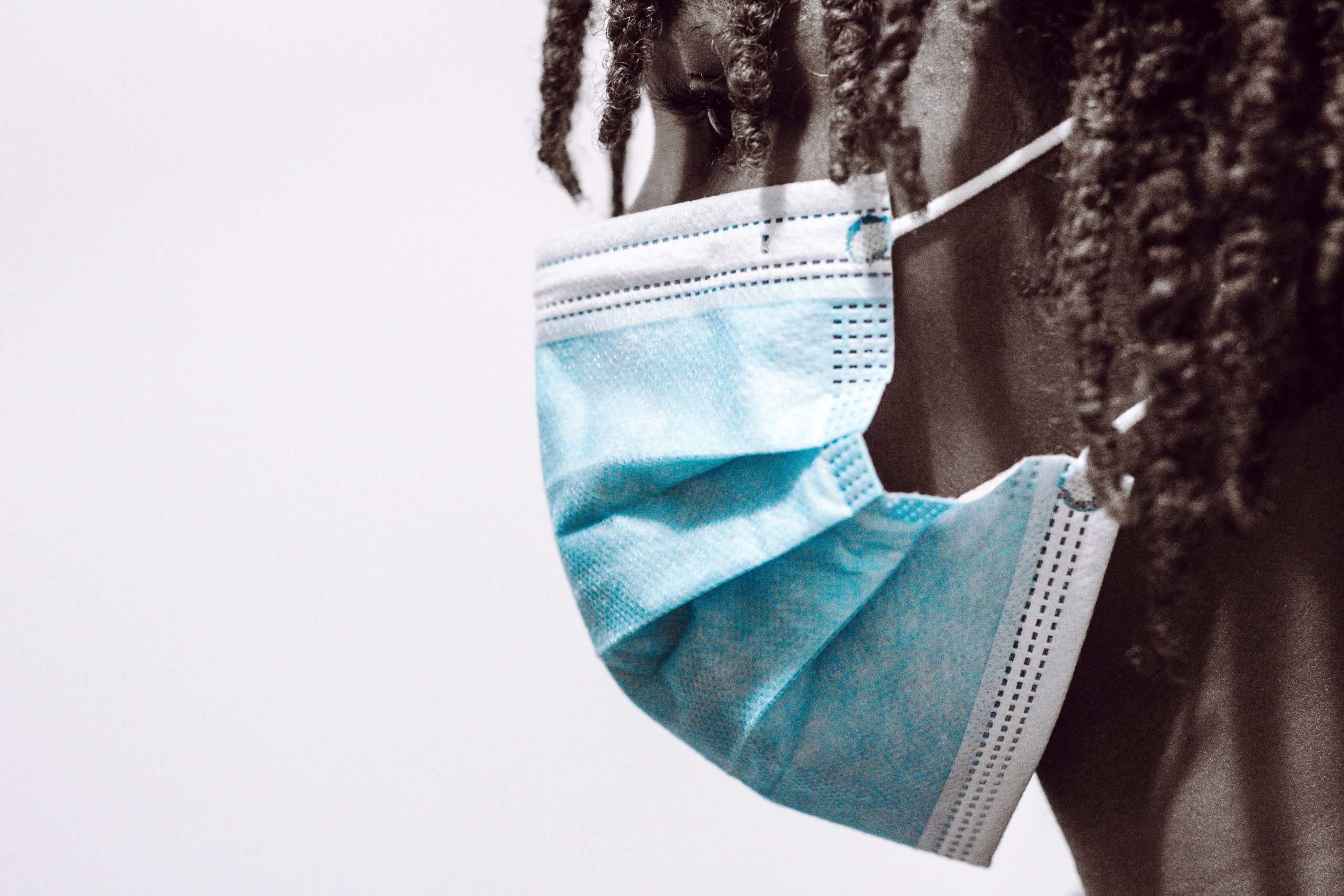On February 14th, 2020, Africa’s first COVID-19 case was reported in Egypt. Since then, there has been widespread speculation about why Africa has not experienced a mass COVID-19 outbreak. At Development Reimagined, our analysis reveals there is no single ‘Africa story’, and that decisive African leadership across the continent, supported by international cooperation, has led to an overall lower COVID-19 prevalence. In this, China played a very interesting, somewhat different role compared to many of Africa’s development partners. But how and why?
When Egypt recorded its case, it was the 25th country in the world to do so. From December 2019 to March 2020, outside of China there was a total of 14,768 COVID-19 cases across 85 countries, yet the continent only equated for 7 of these countries and 27 cases. Currently, the continent has a cumulative total of 100,325 deaths and 3.80 million cases – 3.95% and 3.33% of the world’s total, respectively.

So, What Explains Africa’s COVID-19 Experience?
An abundance of headlines portrays the continent as a ‘mystery’, claiming health systems are not robust enough for test and tracing, or it is more resilient due to a large youth population.
Yet, these perspectives fail to reflect reality. Firstly, COVID-19 highlights that Africa is less connected to the rest of the world, as historically, diseases originating outside Africa have taken longer to reach the continent, with SARS and H1N1 taking five and two months, respectively.
However, it is not simply Africa’s dysconnectivity, but rather rapid and effective responses by governments to mitigate COVID-19 impacts. Our analysis finds that 37 African countries implemented some degree of social distancing measures before recording 10 cases, with 10 of these countries adopting measures before any cases were recorded! Policies to support the economy and the populations most vulnerable were launched, with, for instance, the Mozambique Government providing cash transfers and subsidies to the poorest households, alongside fiscal support to micro-businesses and SMEs.

In late 2019, the Global Health Security index was launched, which ranked which countries would fare better during epidemics based on their preparedness. The US, UK and Netherlands claimed the top three spots. Yet, as research shows, these countries are among the worst performers in COVID-19.
Indeed, in preliminary analysis of our own data collated on the performance of African countries in relation to COVID-19, we have been able to find very few significant predictive factors, aside from the number of cases (and deaths) when governments initiated social distancing. All other factors – such preparedness indices, geographic and demographic factors, and even poverty levels, pale in comparison. Levels of unemployment seem to matter to some extent – and other studies for other countries have found for instance a relationship between poor COVID19 performance and high use of public transport.
The fact is, Africa’s COVID-19 experience was poorly predicted by many, and while there has been suffering on the continent, the relatively less cases and deaths have been a major relief, especially in the context of challenges faced by many of Africa’s traditional development partners in mobilizing significant support to other countries.
That said, China has played a helpful role as a development partner in Africa, and a fairly unique role at that. While several other development partners announced that aid finance would be channeled into vaccine research, or into the COVAX alliance, China took a different, project-by-project as well as multilateral approach.
By March 2020, the Chinese government had provided 12,000 testing kits as well as China’s Public Health and Customs Departments sharing information with health leaders from 20 countries. Furthermore, the Chinese government sent 7 medical teams to 15 African countries throughout the pandemic. Additionally, private sector foundations, such as the Jack Ma Foundation and Alibaba Foundation, donated 4.6 million masks, 500,000 swabs, and test kits, and 300 ventilators to the African Centre of Disease Control.

So What’s Next?
In 2021, African countries will no doubt face serious hurdles in achieving development and poverty reduction. Before COVID19 struck, the IMF was predicting that 6 out of 10 of the fastest-growing economies would have been African. This growth was essential for poverty alleviation, especially as Africa is home to the largest number of poor people globally – at roughly 400 million. Now, in 2021, the IMF forecasts only 22 of Africa’s 55 countries will experience economic growth of over 4%, making just three of the world’s top ten fastest-growing countries.
Building on the Experience of 2020, There Are Two Areas in Which China’s Support Will Be Vital:
First, African countries need fiscal space to divert resources to fighting COVID and economic development. In September 2020, 13 African countries were spending less than 1% of GDP to support citizens and businesses, indicating they could be facing serious fiscal constraints. To partially alleviate constraints, the G20 countries introduced the Debt Service Suspension Initiative (DSSI) to postpone debts for the world’s poorest countries until mid-2021, with 31 African countries accepting DSSI support. Alongside this, additional grants and loans have been pledged by World Bank and IMF member states, with China pledging $2 billion in support for Africa.
Whilst the DSSI provides fiscal space, is it enough to stimulate economic growth?
Put simply, no. These solutions are short-term, and the dual challenge of COVID-19 and development requires money, fast. Economic activity has slowed across the continent, creating further fiscal constraints and slowing development progress. Before COVID-19, the African Development Bank estimated that African governments needed $68 to $108 billion of extra finance every year up to 2025 for infrastructure development. In the continent’s post-COVID recovery, infrastructure financing is vital, with COVID demonstrating the challenges of transporting essential supplies across borders.
So, How Can Different Chinese Actors Support This?
One way is to provide further debt suspension to provide more fiscal space. Our recent analysis with the Oxford China International Consultancy estimates that up to 40% of finance spent on COVID-19 by African countries so far could be covered by suspending debt payments to Chinese official creditors.
Another is for both the Chinese government and private sector to boost its financing and investment[DII1] , through additional loans or public-private partnerships. This will cultivate infrastructure development, which can integrate African countries into global supply chains. Additionally, investments into the manufacturing sector can increase value-added production capabilities and diversify Africa’s exports beyond raw commodities and agricultural products. Increased investment corresponds with China’s new Dual Circulation government strategy, aimed at accelerating China’s transition from a labor-intensive, export economy toward a high-tech, consumption-based economy. As Ethiopian Ambassador Toga stressed in a recent interview, ‘the answer to our current challenges is more cooperation, more investment, and more trade’.
Yet, as travel restrictions and lockdown measures persist, issues regarding due diligence have emerged causing delays in investment projects. To tackle this, countries such as Kenya and Côte d’Ivoire have begun digitizing corporate registries and creating online databases on company filings, although this process is gradual and incomplete. Addressing concerns involves consistent coordination amongst actors on both the Chinese and African sides. This entails increased communication and engagement on information gathering and sharing, including using on-the-ground networks to build confidence in future investment projects.
Second, vaccine cooperation is vital to enabling African governments and citizens to focus on economic recovery. As of early March 2021, our data indicates that 48 African countries and the African Union had placed orders of over 1 billion vaccine doses. Yet, our data indicates that only 12 African countries so far will be able to vaccinate over 20% of their population, with only 3 countries able to cover 40% (the Seychelles, Morocco, and Egypt). Additionally, only 2% of these orders have been delivered so far! This raises the concern that unequal vaccine access will prolong reduced economic activity, and thus development, due to continued social distancing requirements and persistent spending on COVID-19 healthcare and socio-economic support.

What Can China Do?
While some of these orders (8%) and deliveries (17%) to date are from China, more is necessary, especially donated for free and/or at low cost. So far, China has announced it will donate a total of 1.6 million doses to African countries and has announced it will provide 10 million vaccine doses to the COVAX Alliance, which will then be distributed around the world. This is a good start, but more can be done.
In particular, the Chinese government should increase support to the African Union’s (AU) COVID-19 response initiatives as soon as possible, especially the African Centre of Disease Control (Africa CDC) and its COVID-19 African Vaccine Acquisition Task Team (AVATT). So far, China is a partner of the Africa Medical Supplies Platform, which facilitates the procurement of critical COVID-19 medical supplies by African governments. China can extend this by making more vaccine donations to it and providing subsidized equipment through it as well.
However, China can also look to the long-term. A priority for long-term continental resilience is increasing the capacity for vaccines to be manufactured locally, thereby reducing reliance on importing life-saving products. Currently, the continent imports over 80% of its pharmaceutical and medical products. By investing in Africa’s health market, Chinese pharmaceutical players can enhance the continent’s manufacturing capabilities, which would induce positive spillover effects such as access to high-quality pharmaceutical products, facilitating technology transfers, and stimulating job creation within a value-added sector.
Some negotiations have already begun with Chinese manufacturers on COVID-19 vaccines in Morocco, but more is needed with other countries. 34 of 55 African countries have some level of pharmaceutical production. Also, as a report by UNAIDS and the China Chamber of Commerce for Import and Export of Medicines and Health Products reveals, out of 21 African countries surveyed, over 80% provided tax incentives to encourage local production of pharmaceuticals, and several other pharma industry-specific incentives. There is a real opportunity to grab here.
As COVID-19’s challenges continue throughout 2021, Africa’s development partners have an opportunity to work with African governments and organizations to take further short-term actions. As they do, based on lessons learned over 2020, they must make sure they bolster the leadership and decisiveness shown by many African governments and institutions so far and focus on increasing the resilience of African countries in the long-term. That’s what real “win-win” means.
This Q&A was originally published on the China Africa Project Website on 5 March 2021
March 2021


